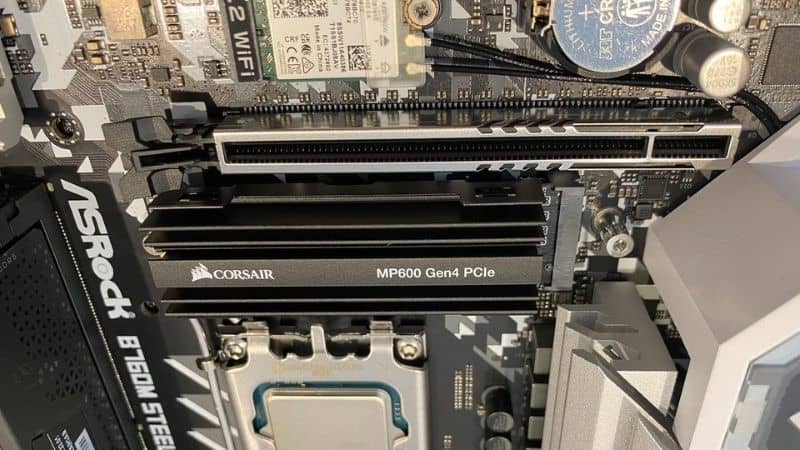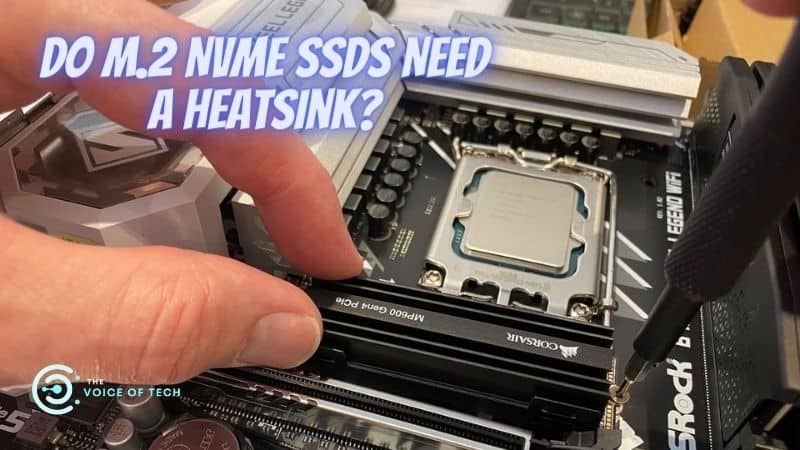
Expert Consulted: Adrian Gardiner. With 30+ years in the IT industry, I get frequent requests to repair, upgrade, and build a wide range of computers, including new gaming PCs. This experience has given me helpful knowledge that I can share to advise on the question of do M.2 SSDs need a heatsink.
With all the talk about the importance of keeping temperatures down in your fancy gaming PC, what about these newer M.2 SSDs that are now becoming so popular? Do they get hot, and if so, how do you keep them cool?
This is where heatsinks come in, and so, to answer the question, do M.2 SSDs need a heatsink?
M.2 SSDs don’t always require a heatsink but are recommended for high-performance variants like many PCIe 5 devices, which can run hotter or in systems with poor airflow to maintain optimal performance. Heatsinks are particularly beneficial during intensive tasks like data transfer or gaming and help to ensure the SSD’s longevity and reliability.
More detail on the subject of hot-running M.2 SSDs and keeping them cool is covered in the rest of this article to help you with your own device selection when upgrading or building your own PC.
Why Do M.2 SSDs Need a Heatsink?
There are a couple of main types of SSD, 2.5″ SATA SSDs, as would have been used in the past as replacements for the older conventional HDDs in laptops and desktops. However, these SATA SSDs are now being steadily replaced by the newer, smaller, and much faster M.2 NVMe SSD drives.
M.2 SSDs are usually fitted directly to the motherboard, meaning less hassle during installation as you have no cables to worry about and only one small screw to secure the drive into place.
M.2 SSDs and Heat
When I build new computers for my clients, I now use M.2 SSDs as it’s much easier to fit them and takes less time.
However, what I have noticed is that some PCIe 4 drives can run hot, and many of the even faster (and more expensive) PCIe 5 devices can quickly get very hot, especially if they’re under any sort of load, like gaming, for example.
If you’re living in a hot climate, temperatures can be even more of a problem, with the SSD getting hot much faster.
This means while it may not be required all of the time to fit a heatsink to PCIe 4 and PCIe 5 M.2 SSDs, I recommend you do so.
The cost of a heatsink is not usually prohibitive; they’re dead easy to fit, and the benefits are definitely worth it in terms of keeping your device cooler and helping it last longer.
What is An M.2 SSD Heatsink?

An M.2 SSD heatsink is usually a thin metallic structure that sits directly on top of the M.2 SSD to draw heat away from the drive’s chips through thermal conductivity.
This process helps to maintain lower temperatures, preventing thermal degradation or damage from overheating. Some heatsinks might include a thermal pad for enhanced conductivity or even fans for active cooling.
Performance Throttling Due to High Temperatures
When your M.2 gets too hot (usually around 70 degrees C), it can start to throttle and very noticeably slow down to prevent damage, and this can happen quite quickly within a few minutes of operation.
This throttling can make a huge difference to the performance of your SSD, especially if you’re using it for demanding tasks like gaming or video editing, for example.
By fitting a heatsink, you can help prevent the possibility of performance throttling and ensure your device is running at its full potential and, of course, lasts longer, too.
Selecting a Suitable Heatsink
Many of the higher specification M.2 SSDs will often come pre-fitted with a heatsink, which is a great time saver.
However, many will not, and selecting the right heatsink is important if you want it to be as effective as possible.
Check the Fit of Your Heatsink
Make sure the heatsink is a good fit for your particular SSD, making sure that it doesn’t interfere with other motherboard components when it’s in place.
Thermal Pad
You’ll need a good-quality thermal pad to place between the SSD and the heatsink. Most heatsinks will usually come with their own thermal pad, but you can also buy them separately.
A thermal pad is like the thermal paste you apply to the surface of your computer CPU and the heatsink that rests on top.
This pad acts as the thermally conductive interface to efficiently transfer heat away from the SSD to the heatsink, which is then cooled by airflow through your PC case.
Frequently Asked Questions

Here are a couple of common questions that I’ve been asked about whether M.2 SSDs need a heatsink.
Q1: Do motherboards come with heatsinks?
Some high-end motherboards do come pre-fitted with built-in M.2 SSD heatsinks (and a thermal pad), nicely designed to blend in with the motherboard.
However, the likelihood is that you’ll probably have to buy a heatsink for most M.2 SSDs.
Q2: Can I install an M.2 SSD heatsink on my own?
Yes, these drives are usually pretty easy to fit. Make sure you have the right SSD for the slot on your motherboard. Also, take care when lining it up with the slot, and be extra gentle when securing it with the provided screw, as it’s all too easy to over-tighten and damage the screw thread.
Final Thoughts
Not all M.2 SSDs will strictly need a heatsink, but I think it’s a good idea to fit one anyway, especially bearing in mind their relatively low cost and ease of fitting.
The more recent PCIe 4 and PCIe 5 SSDs generate more heat, so I’d always consider fitting a heatsink if they didn’t already come with one pre-fitted.
Even if your particular SSD doesn’t get too hot, there may come a time when the cooling inside your PC case becomes hotter than usual due to other components, higher than usual outside summer temperatures, or perhaps a build-up of dust that reduces the effectiveness of your cooling.

